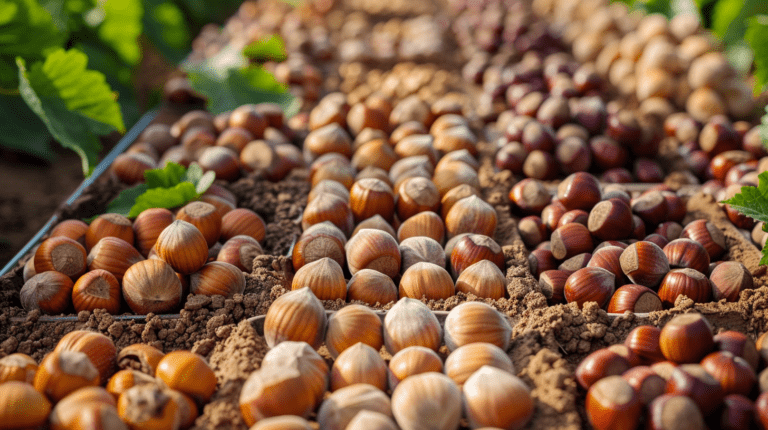How Different Hazelnut Varieties Affect Taste in Confections
Hazelnuts have long been a staple in confectionery, celebrated for their unique flavor profiles and versatility. The variety of hazelnuts used can significantly influence the taste and texture of confections, making the choice of hazelnut variety a critical decision for chocolatiers and pastry chefs. This article explores the diverse world of hazelnut varieties, their distinct flavor profiles, and their impact on confections.
Major Hazelnut Varieties and Their Flavor Profiles
Hazelnuts are cultivated in various regions around the world, each offering unique varieties with distinct flavors. The most prominent varieties include European, American, and Turkish hazelnuts.
– European Hazelnut (Corylus avellana)
- Barcelona: This variety is known for its rich, nutty flavor with sweet undertones. It is widely used in confectionery due to its balanced taste and good shelf life1.
- Tonda Gentile: Prized for its sweet taste and fine texture, Tonda Gentile is a preferred choice for high-quality chocolate products and desserts1.
– American Hazelnut (Corylus americana)
- American Hazelnut: This variety offers a slightly bitter taste with earthy undertones. While not as common in commercial products, its unique flavor and high oil content are valued in certain culinary applications1.
– Turkish Hazelnut (Corylus colurna)
- Cakildak: Known for its complex flavor profile with a high content of volatile compounds, Cakildak has an intense and slightly astringent taste1.
- Palaz: Offers a balanced flavor with moderate volatile compounds, resulting in a well-rounded taste1.
- Tombul: Appreciated for its sweet and nutty flavor, Tombul is popular for both raw consumption and processed products1.
Comparative Analysis of Hazelnut Flavors
The sensory evaluation of hazelnuts reveals common descriptors such as nutty, sweet, earthy, and astringent. Understanding these flavor characteristics is essential for selecting varieties that align with consumer preferences and market demands.
- Barcelona: Nutty and sweet with a rich aftertaste.
- Tonda Gentile: Sweet with a delicate texture.
- American Hazelnut: Earthy and slightly bitter.
- Cakildak: Intense and slightly astringent.
- Palaz: Balanced and well-rounded.
- Tombul: Sweet and nutty1.

Applications of Different Hazelnut Flavors in Confectionery
The diverse flavor profiles of hazelnuts make them suitable for various culinary applications. In confectionery, European varieties like Tonda Gentile and Barcelona are favored for their sweetness and fine texture, enhancing chocolates and pastries. Turkish varieties such as Palaz and Tombul are ideal for nut butter and spreads due to their balanced and nutty flavors. Additionally, the unique taste of American hazelnuts can be utilized in savory dishes and specialty oils, adding a distinct earthy note1.
The Role of Hazelnuts in Chocolate Confections
Hazelnuts are particularly celebrated when paired with chocolate, creating iconic combinations that have become staples in the confectionery industry.
– Popular Chocolate-Hazelnut Creations
- Chocolate-Hazelnut Spreads: These spreads blend creamy chocolate with finely ground hazelnuts, making them perfect for toast or as pastry fillings2.
- Truffles and Pralines: Featuring rich hazelnut centers enrobed in smooth chocolate, these confections offer luxurious indulgence2.
- Chocolate Hazelnut Gelato: A creamy dessert combining chocolate richness with nutty undertones2.
- Chocolate Hazelnut Torte: Layers chocolate sponge with hazelnut-infused cream or ganache2.
- Biscotti and Cookies: Often feature chunks of hazelnuts and chocolate chips2.
These creations highlight the harmonious blend of chocolate and hazelnuts, appealing to consumers worldwide.
Trends in Hazelnut Consumption
The global market has seen a rise in chocolate-hazelnut products. In 2020, Nutella’s popularity underscored this trend as it became one of the top grocery items in France. The demand for hazelnuts is driven by their nostalgic appeal and versatility in both sweet and savory dishes3.
– Innovation in Confectionery
Manufacturers are leveraging the popularity of hazelnuts by introducing new product lines like chocolate bars with hazelnuts or hazelnut-flavored coffee. The trend towards nostalgic flavors continues to drive consumer interest, especially among millennials seeking new culinary experiences3.
Conclusion
Understanding the flavor profiles of different hazelnut varieties is crucial for growers, enthusiasts, and consumers alike. European, American, and Turkish hazelnuts each offer unique taste experiences influenced by their genetic makeup and cultivation practices. As research advances, new hazelnut varieties with enhanced flavors promise exciting possibilities for the future.
This diversity enriches culinary applications while benefiting agricultural sectors by meeting varied consumer preferences. Whether used in classic confections or innovative new products, hazelnuts continue to play an essential role in the world of sweets.
Sources:
[1] https://hazelnuthub.com/discovering-the-flavors-of-hazelnut-varieties/
[2] https://premiumgrowers.com/hazelnuts-and-chocolate/
[3] https://www.freyabadi.com/en/blog/the-rise-of-hazelnut-products
[4] https://in-confectionery.com/latest-ingredient-trends-in-chocolate-confectionery-and-spreads/
[5] https://www.hazelnut.com/about-hazelnuts/varieties/
[6] https://www.mordorintelligence.com/industry-reports/global-hazelnut-market/market-trends
[7] https://www.trendhunter.com/trends/tim-hortons-x-nutella
[8] https://ratinkhosh.com/all-about-hazelnuts/
[9] https://www.agrownet.com/contents/en-us/d341197_Hazelnuts_Varieties_List.html
[10] https://www.ferrerohazelnutcompany.com/int/en/our-hazelnuts/about-hazelnuts






